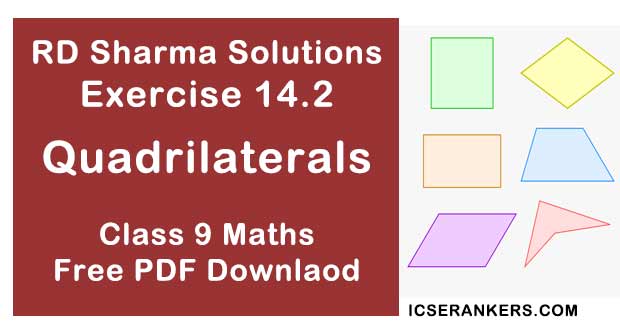Chapter 14 Quadrilaterals RD Sharma Solutions Exercise 14.2 Class 9 Maths

Chapter Name | RD Sharma Chapter 14 Quadrilaterals Exercise 14.2 |
Book Name | RD Sharma Mathematics for Class 10 |
Other Exercises |
|
Related Study | NCERT Solutions for Class 10 Maths |
Exercise 14.2 Solutions
1. Two opposite angles of a parallelogram are (3x - 2)° and (50 - x)° . Find the measure of each angle of the parallelogram.
Solution
We know that
Opposite sides of a parallelogram are equal
∴ 3x 2 = 50 - x
⇒ 3x + x = 50 + 2
⇒ 4x = 52
⇒ x = 13°
∴ (3x - 2)° = (3 × 13 - 2) = 37°
(50 - x)° = (50 - 13°) = 37°
Adjacent angles of a parallelogram are supplementary
∴ x + 37 = 180°
∴ x = 180° - 37° = 143°
Hence, four angles are : 37°, 143°, 37° , 143°
2. If an angle of a parallelogram is two - third of its adjacent angle, find the angles of the parallelogram.
Solution
Let the measure of the angle be x
∴ The measure of the angle adjacent is 2x/3
We know that the adjacent angle of a parallelogram is supplementary
Hence x + 2x/3 = 180°
2x + 3x = 540°
⇒ 5x = 540°
⇒ x = 108°
Adjacent angles are supplementary
⇒ x + 108° = 180°
⇒ x = 180° - 108° = 72°
⇒ x = 72°
Hence, four angles are : 180° , 72°, 108°, 72°
3. Find the measure of all the angles of a parallelogram, if one angle is 24° less than twice the smallest angle.
Solution
Let the smallest angle be x
Then, the other angle is (3x - 24)
Now, x + 2x - 24 = 180°
3x - 24 = 180°
⇒ 3x = 180° + 24
⇒ 3x = 204°
⇒ x = 204/3 = 68°
⇒ x = 68°
⇒ 2x -24° = 2×68° - 24° = 136° - 24° = 112°
Hence four angles are 68°, 112°, 68°, 112°
4. The perimeter of a parallelogram is 22cm. If the longer side measures 6.5 cm what is the measure of the shorter side ?
Solution
Let the shorter side be x
∴Perimeter = x + 6.5 + 6.5 + x
22 = 2(x + 6.5)
11 = x + 6.5
⇒ x = 11 - 6.5 = 4.5 cm
∴ Shorter side = 4.5 cm
5. In a parallelogram ABCD, ∠D = 135°, determine the measures of ∠A and ∠B.
Solution
In a parallelogram ABCD
Adjacent angles are supplementary
So, ∠D + ∠C = 180°
135 + ∠C = 180°
⇒ ∠C = 180° - 135°
⇒ ∠C = 45°
In a parallelogram opposite sides are equal
∠A = ∠C = 45°
∠B = ∠D = 135°
6. ABCD is a parallelogram in which ∠A = 70°. Compute ∠B, ∠C and ∠D.
Solution
In a parallelogram ABCD
∠A = 70° [∵ Adjacent angles supplementary]
∠A = ∠B = 180°
⇒ 70° + ∠B = 180° [∵ ∠A = 70°]
⇒ ∠B = 180° - 70° = 110°
In a parallelogram opposite sides are equal
∠A = ∠C = 70°
∠B = ∠D = 110°
7. In fig., below, ABCD is a parallelogram in which ∠A = 60 . If the bisectors of ∠A and ∠B
meet at P, prove that AD = DP, PC = BC and DC = 2AD.
Solution

Then, ∠AP = ∠PAB = 30°
Adjacent angles are supplementary
BP bisects ∠B
Then, ∠PBA + ∠PBC = 30°
Similarly
∠PBA = ∠BPC = 60° [Alternative interior angle]
DC = DP + PC
⇒ DC = AD + BC [∵ DP = AD, PC = BC]
⇒ DC = 2AD


∠BEF = ∠CED [Verified opposite angle]
BE = CE [∵ E is the mid - point of BC]

∵ ΔBEF ≅ ΔCED [Angle side angle congruence]
∵ BF = CD [Corresponding Parts of Congruent Triangles]
AF = AB + AB
AF = 2AB

